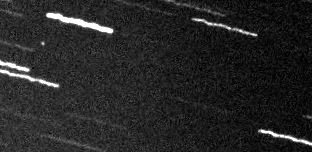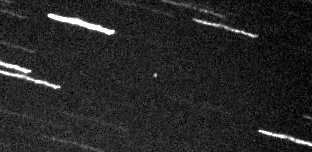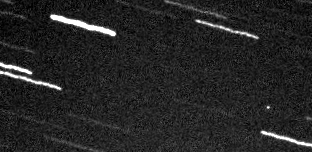After a long hiatus due to some serious site renovations, Shenton Park Observatory is back on-line and has immediately provided important follow up work for JPL on 2010 DJ1 – the fastest moving NEO yet tracked by us.
Discovered on Feb 18, 2010 DJ1 is a small Apollo with a diameter estimated to be about 15m. On February 18, Lance Brenner (JPL solar system radar studies team) posted a request for additional astrometric observations in order to reduce the ephemeris uncertainty required in order to undertake successful radar observations during closest Earth approach.
In response to this request, Paulo Holvorcem scheduled observations for the period that the object would be visible at Shenton Park Observatory (D21) on February 21st. During its observation, 2010 DJ1’s motion would increase to 122 degrees per day – easily surpassing our previous record of 92 degrees per day when we tracked 2007 VF189. During this period, the object came to within 1.5 lunar distances from Earth, utlimately reaching about 1.0 lunar distance some 6 hours after the end of our observations. Shenton Park Observatory was the last station to observe the object before it went into solar conjunction and became too faint to observe.
Images were fed real time into Paulo’s “SkySift” pipeline. Astrometry was sent to the MPC and Lance Brenner for orbit refinement. MPEC 2010-D60 shows astrometry from both the Siding Spring Survey (E12) and Shenton Park Observatory (D21). Although no attempt was made to coordinate observations, the last observations from E12 were followed by the first from D21 – the two stations providing nearly continuous coverage of 2019 DJ1 from 2010 Feb. 21.43 to 21.70 UT.
Paulo produced a plot of the magnitudes of 2010 DJ1 measured in the long image series taken at D21. The magnitude measurements, although not the the result of careful photometric redcuction, display some coherence in time and suggest that the object is not a fast rotator – with a rotation period in the order of 40 minutes.
With the observations from D21, ephemeris uncertainty had been reduced to the level required for radar observations. Unfortunately, as of the time of this writing, the JPL radar team are still analysing their radar data after experiencing equipment problems during radar observation.
The sequence of images below shows 2010 DJ1 moving at about 100 degrees per day. These are 24 second exposures with the object at about magnitude 16.



